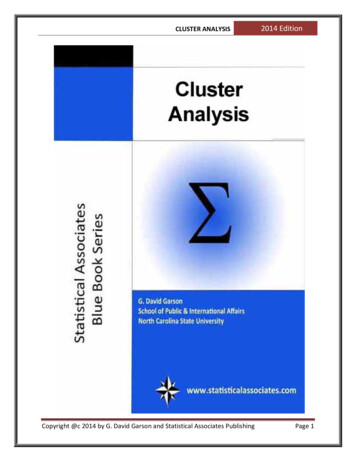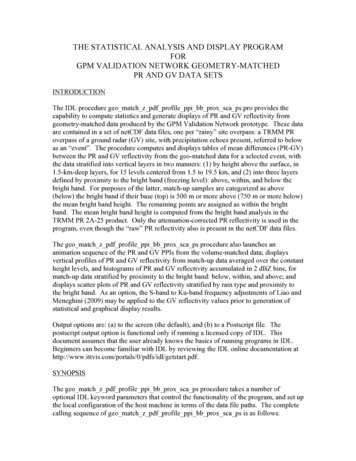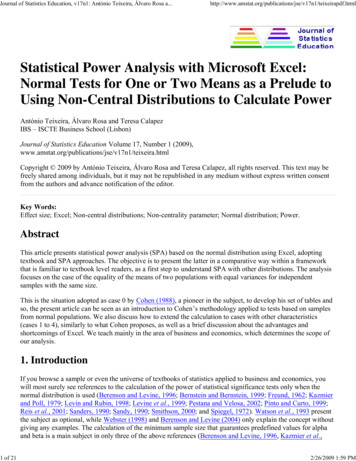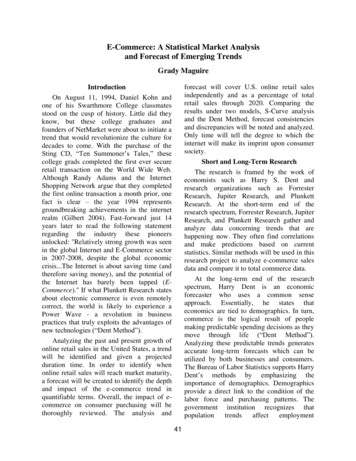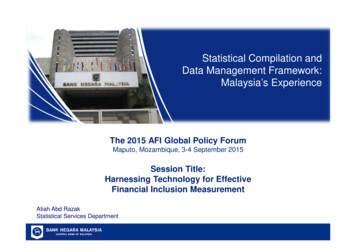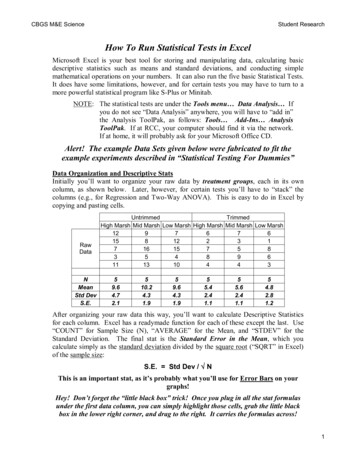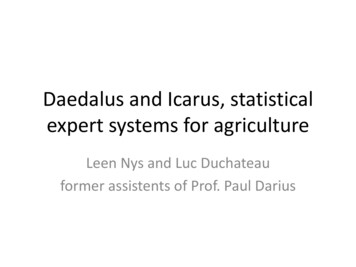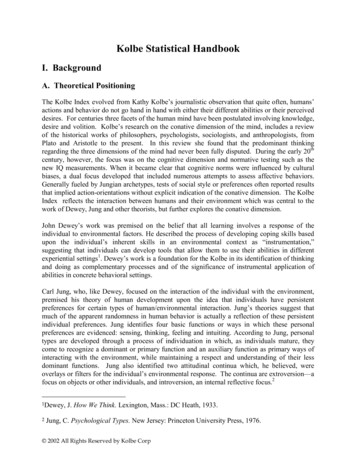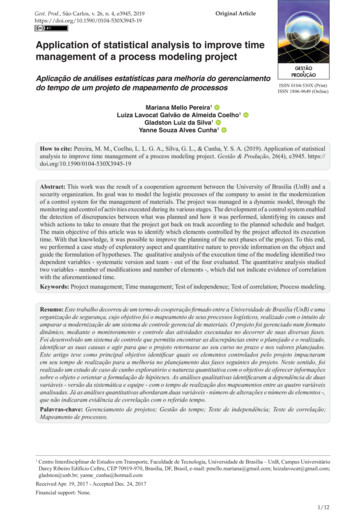
Transcription
Gest. Prod., São Carlos, v. 26, n. 4, e3945, al ArticleApplication of statistical analysis to improve timemanagement of a process modeling projectAplicação de análises estatísticas para melhoria do gerenciamentodo tempo de um projeto de mapeamento de processosISSN 0104-530X (Print)ISSN 1806-9649 (Online)Mariana Mello Pereira1 Luiza Lavocat Galvão de Almeida Coelho1 Gladston Luiz da Silva1 Yanne Souza Alves Cunha1 How to cite: Pereira, M. M., Coelho, L. L. G. A., Silva, G. L., & Cunha, Y. S. A. (2019). Application of statisticalanalysis to improve time management of a process modeling project. Gestão & Produção, 26(4), e3945. https://doi.org/10.1590/0104-530X3945-19Abstract: This work was the result of a cooperation agreement between the University of Brasilia (UnB) and asecurity organization. Its goal was to model the logistic processes of the company to assist in the modernizationof a control system for the management of materials. The project was managed in a dynamic model, through themonitoring and control of activities executed during its various stages. The development of a control system enabledthe detection of discrepancies between what was planned and how it was performed, identifying its causes andwhich actions to take to ensure that the project got back on track according to the planned schedule and budget.The main objective of this article was to identify which elements controlled by the project affected its executiontime. With that knowledge, it was possible to improve the planning of the next phases of the project. To this end,we performed a case study of exploratory aspect and quantitative nature to provide information on the object andguide the formulation of hypotheses. The qualitative analysis of the execution time of the modeling identified twodependent variables - systematic version and team - out of the four evaluated. The quantitative analysis studiedtwo variables - number of modifications and number of elements -, which did not indicate evidence of correlationwith the aforementioned time.Keywords: Project management; Time management; Test of independence; Test of correlation; Process modeling.Resumo: Este trabalho decorreu de um termo de cooperação firmado entre a Universidade de Brasília (UnB) e umaorganização de segurança, cujo objetivo foi o mapeamento de seus processos logísticos, realizado com o intuito deamparar a modernização de um sistema de controle gerencial de materiais. O projeto foi gerenciado num formatodinâmico, mediante o monitoramento e controle das atividades executadas no decorrer de suas diversas fases.Foi desenvolvido um sistema de controle que permitiu encontrar as discrepâncias entre o planejado e o realizado,identificar as suas causas e agir para que o projeto retornasse ao seu curso no prazo e nos valores planejados.Este artigo teve como principal objetivo identificar quais os elementos controlados pelo projeto impactaramem seu tempo de realização para a melhoria no planejamento das fases seguintes do projeto. Neste sentido, foirealizado um estudo de caso de cunho exploratório e natureza quantitativa com o objetivo de oferecer informaçõessobre o objeto e orientar a formulação de hipóteses. As análises qualitativas identificaram a dependência de duasvariáveis - versão da sistemática e equipe - com o tempo de realização dos mapeamentos entre as quatro variáveisanalisadas. Já as análises quantitativas abordaram duas variáveis - número de alterações e número de elementos -,que não indicaram evidência de correlação com o referido tempo.Palavras-chave: Gerenciamento de projetos; Gestão do tempo; Teste de independência; Teste de correlação;Mapeamento de processos.1Centro Interdisciplinar de Estudos em Transporte, Faculdade de Tecnologia, Universidade de Brasília – UnB, Campus UniversitárioDarcy Ribeiro Edifício Ceftru, CEP 70919-970, Brasília, DF, Brasil, e-mail: pmello.mariana@gmail.com; luizalavocat@gmail.com;gladston@unb.br; yanne cunha@hotmail.comReceived Apr. 19, 2017 - Accepted Dec. 24, 2017Financial support: None.1/12
Pereira, M. M. et al.1 IntroductionIn general, organizations are recognized for theirflexibility, professionalism, and ability to serve theircustomers in a satisfactory manner. The competitionfor this recognition in business increases every day.Organizations must meet the expectations of theircustomers in regard to delivery, cost, and scope(Vargas, 2005). Additionally, in many cases, theyneed to be innovative to satisfactorily attend to thewishes of their clients (Candido et al., 2012).In this scenario, projects - responsible for developingnew products and improving processes - become anecessity as they play an important role in the strategicmanagement of organizations (Marques & Plonski,2011). They are seen as an element of change, ofstrategy implementation, and of innovation since theyprovide organizations with competitive advantages(Marques & Plonski, 2011).In this context, project management is fundamentalto employ resources and efforts prioritizing whatis needed; execute planning based on objectives;form flexible working teams; and be responsible forparadigm breaks so the manager can ensure the successof the enterprise (Vargas, 2005; Candido et al., 2012).According to Vargas (2005), project management hasthe ability to identify and supervise time, cost, andscope constraints. If rigorous, it provides the focus toreach efficiency in communication, coordination, andcontrol resulting in the success of the organization.Despite their importance, most projects do notmeet their goals (Marques & Plonski, 2011). Successin project management is only achieved when it getspositive measurement results in indicators of cost, time,quality, and productivity (Giacometti et al., 2007).According to Kerzner & Saladis (2011), thereare two components of success in a project: criticalsuccess factors (CSF) and key performance indicators(KPI). CSFs are essential to the success of a particularstrategy as they underline the more valuable factorsto reach the expected results. Regarding KPIs, theymeasure the processes used to achieve the goals andquantify the results found, therefore, allowing theevaluation of strategic performance.There is a problem with the traceability of CSFs,which is usually identified at the end of the project.As for the KPIs, they are tracked throughout theproject and constitute measurement instrumentsthat indicate if the CSFs will be obtained and usedto assist the organization in evaluating its progresswhen it comes to goals or declared strategic objectives(Kerzner & Saladis, 2011).In this context, the object of study of this workwas a research project on a large public company.Instead of planning the project in a predictive way,we used a dynamic model in successive waves. Eachintermediate stage implemented its own planning2/12Gest. Prod., São Carlos, v. 26, n. 4, e3945, 2019during the execution of the project, with deadlines,CSFs, and KPIs well-defined.For the continuation of this project, the team monitoredand controlled the activities done in each phase to assistin the planning of the next one. The control systemwas a vital element in the project management since itcould detect discrepancies between what was plannedand how it was performed. With the knowledge ofthese discrepancies, the project manager, with the aidof the team, was able to identify what caused thesedifferences and take action to ensure that the projectgot back on track according to the planned scheduleand budget (Giacometti et al., 2007).A critical success factor for the viability of aproject is its execution time, which can ensurehigher competitiveness among rival organizations(Padilha et al., 2004). That said, this article aims toidentify which elements controlled by the projectaffected key performance indicators related toexecution time, in order to improve the planning ofthe next phases of the project.The article was structured into six sections, withthis one as the first. The second section brings thetheoretical framework, followed by the methodology,the characterization of the case study, data analysis,conclusion, and references.2 Project managementTo understand what is project management, first,we need to know what is a project. Project is atemporary endeavor undertaken to create a uniqueproduct, service or result with a well-defined objective,scope, and resources under cost, time, and qualityconstraints (Kerzner, 2006; PMI, 2016). Accordingto Slack et al. (2009), project is the process of settingresources and/or activities to meet the functionalrequirements of customers through a product, serviceor the transformation process that produces it.Projects can be implemented in virtually allareas of human knowledge and reach all levelsof an organization. Often, they will extrapolatethe boundaries of the organization and reach itsstakeholders, becoming part of its business strategyin most cases (Vargas, 2005).Regardless of the type of project, they all go throughthe same life cycle, which consists of four distinctphases: planning, execution, implementation, andcompletion. Each phase has its own set of objectives,activities, tools, and skills. As a result, the projectmanager will have to act taking what each of themneeds into account (Duffy, 2008).As stated by Alencar et al. (2007), the phases ofa life cycle can vary according to the nature of theproject, but overall, they include viability (initialphase), planning, execution, control, and completion.Different people can manage each of these phases,and not everyone on the team will be involved
Application of statistical analysis from start to finish. It is in this scenario that projectmanagement comes into existence.Project management means applying skills,knowledge, and techniques for the effective andefficient execution of the project to meet the desiredresults (Heldman, 2005; PMI, 2016). It can also bedefined as the planning, scheduling, and control ofconnected activities with the purpose of achievinggoals (Kerzner, 2006).According to Vargas (2005), project management is aset of managerial tools that control single, non-repetitiveand complex events, within a predetermined contextin relation to time, cost, and quality. For this controlto exist, the managerial tools allow the organizationto develop a set of skills, knowledge, and individualcapabilities.Project management is a way of meeting projectgoals through planning, execution, monitoring, andcontrol of activities (Lewis, 2000). It is considered acomplex and challenging activity that has unlimitedpotential, but with predictable patterns, despitethese characteristics (Duffy, 2006). It can detectand control costs and deadlines while maintainingcompetitiveness to exceed the expectations ofcustomers (Bomfin et al., 2012).The objective of project management is to trace,disseminate, monitor, and fix the path the projectswill take, considering the risks, uncertainties,contingencies, failures, and changes that may occurin this period. It covers the identification of needs; theestablishment of goals; the balance between quality,time, scope, and cost; the adaptation to changes; andthe expectations of stakeholders (Jordão et al., 2015).Project management is performed through theappropriate application and integration of someprocesses belonging to five groups defined by thePMBOK Guide: Initiating; Planning; Executing;Controlling; and Closing (PMI, 2013). These processgroups are phases that comprise the life cycle ofthe project. Each process produces results that willbecome inputs for the next process group by meansof successive interactions as shown in Figure 1(Heldman, 2005).The objective of the initiating process groupis to define a new project or a new project phase,confirming their start after the identification andsurvey of physical, financial, staff, and stakeholdersneeds, and giving the necessary permissions aftera thorough feasibility study (Candido et al., 2012;PMI, 2013).The initiating process group will become an inputto the planning process group. The goal of this secondgroup is to consolidate a project plan that includescustomer requirements, the scope of the project,schedule, budgets, and communication plan amongother items (PMI, 2013). Planning is not static and canundergo modifications throughout the life cycle of theGest. Prod., São Carlos, v. 26, n. 4, e3945, 2019project. Therefore the project manager, with the helpof the team, must be attentive to the documentationand its updates (Candido et al., 2012).The planning process group will provide inputfor the executing process group, which will have thepurpose of implementing what was defined to meetthe established specifications. It must constantly beupdated with the input from the controlling processgroup. This last group is characterized by processesof monitoring, analysis, and control of the progressand performance of the project. It establishes thenecessary changes by comparing what was executedto how it was planned (PMI, 2013). Controlling isfundamental to the success of the project as theyallow the identification of problems in enough timeto be solved (Candido et al., 2012).Lastly, the closing process group aims to concludeall activities of all process groups for a formalclosure of the project or phase using records thatwill contribute to increase the know-how of theorganization (Candido et al., 2012; PMI, 2013).The PMBOK Guide mentions a total offorty‑seven (47) processes grouped into ten (10)areas of knowledge. Twenty-four (24) of these groupsbelong to the planning process group, making it themain operational guideline of project management(Jugend et al., 2014).In a study conducted by Terribili (2013), the fivemain problems raised by Brazilian organizations aredirectly related to four disciplines included in thePMBOK Guide: time management, scope management,communication management, and cost management.Of the participating organizations, 60.2% reportthat they are “not meeting deadlines”, i.e., in everyfive organizations surveyed, three have problemsFigure 1. Project Management Process Groups. Source:Heldman (2005).3/12
Gest. Prod., São Carlos, v. 26, n. 4, e3945, 2019Pereira, M. M. et al.with time management (Terribili, 2013). The delaysin a project may be unavoidable, but, at the sametime, they can be mitigated by a good control ofthe progress of the project, which will readjust theschedule to accommodate the delays and bottlenecksthat happen during execution (Duffy, 2008).After conducting a root cause analysis, we canconclude that the reason for delays in projects stemsfrom several variables, many of which transcend thebehavioral characteristics of the project manager andmaterialize in aspects of administration, managerialskills, and non-technical expertise (Terribili, 2013).Terribili (2011) identifies eight groups of potentialcauses of delays in projects: poorly defined scope,badly estimated deadlines, insufficient humanresources, delays in the execution of activities,delays in deliveries from suppliers, tested qualitybelow expectations, excessive bureaucracy in theorganization, and risks that become a reality.Kerzner (2010) emphasizes that the successfulimplementation of processes and methodologies isnecessary to achieve excellence in project management.The managerial level of the company cannot ignorehow the organization uses information. It is thisinformation that will help the manager make decisions,find solutions, and deal with customer satisfaction(Bomfin et al., 2012). According to Fonseca (2006,p. 35), “[ ] well managed projects reduce uncertaintiesand achieve customer satisfaction.”Numerous problems arise during management.If treated in a static manner, they result in theincidence of delays in the schedule and unwantedcosts, regardless of the advances in technologyand management techniques. It takes a huge effortin planning and control of project management tomitigate these chronic symptoms (Lee et al., 2005).3 MethodologyThis research can be classified as a case studyof exploratory and quantitative nature. We usedsome working documents containing sensitive dataas support to find a conclusive result and reach theobjectives of the article.The research is exploratory since its goal is to provideinformation about the object and guide the formulationof hypotheses (Cervo et al., 2007). Furthermore,according to Gonçalves (2014), exploratory researchaims to discover, to find, to elucidate phenomena orto explain those that were not accepted despite beingevident. That way, it reiterates the objective of thisstudy to investigate a phenomenon that will directlyaffect the work routine.Regarding technical procedures, the research is acase study as it is applied directly to the reality of oneproject. Yin (1984) posits that a case study consistsof an intensive analysis of a particular situation4/12investigated, without significant interference fromthe researcher.In this case, the site of analysis was a researchproject that started with a cooperation agreementbetween federal institutions - the University of Brasilia(UnB) - and a security organization. The requiredresult was the modeling of logistic processes, in orderto assist in the modernization of a control system forthe management of materials.Several supporting documents served as managementcontrol and were used as input for the development ofthis article, such as general spreadsheet of processes,update control tool, team data spreadsheet amongothers. In this regard, the case study had the aidof documentary research and statistical analysis toachieve its goal.The study has a quantitative nature, which,according to George & Bennett (2005), is based onstatistical techniques to describe the reality beinginvestigated. The statistical analysis used demonstratesthe relationship between the delays at work and sixselected variables (Duration of the Project, Stageof Material, Systematic Version, Team, Number ofModifications, and Number of Elements). In thisrespect, one of the ways to evaluate the effectivenessand efficiency of the monitoring process is throughthe application of statistical methods.3.1 Statistical analysesWe conducted statistical analyses to verify thesimilarity between the selected variables and theexecution time of activities, thus determining theeffectiveness of the project management process.To this end, we used the test of independence andthe test of correlation, explained, respectively, ontopics 3.1.1 and 3.1.2.3.1.1 Test of IndependenceThe Test of Independence between two qualitativevariables is performed using data available in acontingency table (double entry). The cells of thistable contain the respective frequencies observed,as presented in Table 1.In this test, we consider the independence betweenthe variables A and B as a null hypothesis, that is,the marginal proportion of variable A in the i-th class( ni. / n. ) can be found in any class of variable B, nij / n.j .Similarly, the marginal proportion of variable B inthe i-th class n.j / n. can be found in any class of((()))variable A n ij / n i. .Formally, we could consider pij as the probabilityof an element being classified in categories i and j atthe same time, with pi. and p.j as marginal probabilities.Consequently, we could write the hypothesis ofindependence as follows:
Gest. Prod., São Carlos, v. 26, n. 4, e3945, 2019Application of statistical analysis Table 1. Contingency table of categorical variables A and B.Variable iable H0: pij pi. . p.j, for each pair (i, j);1 1 ρ01 µξln and σξ2.(4)2 1 ρ0n 3H1: pij pi. . p.j, for any pair (i, j).We could describe such hypotheses literally as:with n as the sample size (X1, Y1), ., (Xn, Yn) and ρ0 asH0: The variables (A, B) are independent;the value of the population parameter. The approachH1: The variabl
Project management means applying skills, knowledge, and techniques for the effective and efficient execution of the project to meet the desired results (Heldman, 2005; PMI, 2016). It can also be defined as the planning, scheduling, and control of connected activities with the purpose of



